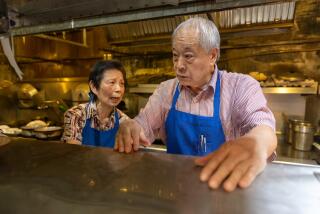GASLAMP THEATRE DRAWS ON AREA’S CHINESE ROOTS
- Share via
SAN DIEGO — The remnants of San Diego’s Chinatown will never rival the exotic glamour of its San Francisco counterpart. But this ethnic enclave, nestled in the downtown Gaslamp Quarter, is beginning a cultural reawakening.
In addition to the presence of the Chinese Historical Museum, recently installed at the reconstructed Horton Grand Hotel, this weekend the Gaslamp Quarter Theatre will inaugurate a series of Chinese musical performances.
“Our current theater building used to be a Chinese dance hall,” said Gaslamp Theatre managing producer Kit Goldman, “and when we moved in, an elderly Chinese gentleman had lived here for 40 years.”
With the construction of the Gaslamp Theatre’s permanent home and second stage--the 250-seat Deane Theatre on lower 4th Avenue adjacent to the Horton Grand Hotel--Goldman began to look for ways of relating to the neighboring ethnic community. She found that members of the Chinese-American business community were not particularly eager to contribute to the Gaslamp Theatre’s building fund, but they warmed to the idea of helping sponsor Chinese cultural events.
Goldman’s search brought her to Sally Wong, chairwoman of the local Chinese Historical Society, who put her in contact with the three Chinese performers. Sunday’s concert, which will be repeated Monday and Tuesday nights, is the Gaslamp Theatre’s pilot project for the series.
“We want to establish ourselves as presenters of Chinese arts and entertainment,” explained Kristina Farhood, the theater’s marketing director. The group is negotiating with a Los Angeles-based Chinese dance troupe for the next event.
This first concert of Chinese chamber music will feature three performers from China. In addition to traditional Chinese music, they will play modern Chinese music for both Oriental and Western instruments, and even a smattering of Western music. The leader of the ensemble, China Lin, is a skilled performer on two traditional Chinese instruments, the bawa and the two-stringed erhu . Although the bawa looks like a transverse flute and is held horizontally when played, it actually has a small metal reed inside that makes its tone more nasal than that of a flute.
The erhu is a bowed string instrument, held vertically like a cello, although it is smaller and rests on the player’s thigh, rather than on the floor. Among the erhu’s unusual characteristics is the snakeskin covering, usually python, of the small resonator at the instrument’s base. Lin’s concerto for solo erhu and orchestra will be premiered next month at United States International University.
He Yue-Yuan will perform solos on the pipa, sometimes called the Chinese lute, a pear-shaped, fretted instrument with four strings. Associated with Chinese court music, the pipa traditionally provided music at banquets. It is held upright, and when it is plucked vigorously, it sounds like an American 12-string banjo.
Violinist He Dong, concertmaster of the Canton Symphony, achieved his enviable musical reputation in China on a Western instrument, rather than on a traditional Chinese instrument. He will play Fritz Kreisler chestnuts as well as violin pieces by modern Chinese composers.
For the last year, Lin and Dong have been in residence at USIU, playing there with conductor Zoltan Rozsanyai’s International Orchestra. For these performances at the Gaslamp Theatre, Yue-Yuan came down from San Francisco, where she resides. Since Lin has made piano arrangements of the orchestral accompaniments for some of his own compositions and for some of the traditional Chinese melodies, USIU accompanist Zsuzsu Heiligenberg will provide piano accompaniment for Lin and Dong.
Of particular interest is the Chinese traditional music, most of which is quite descriptive, or, in terms of Western music, programmatic. Unlike Chinese opera, which is noted for its esoteric musical and dramatic qualities, Chinese instrumental music is predominantly lyrical and accessible to Western ears.
Typical titles give pictorial accounts of the music’s imagery: “The Fishing Boat Comes in the Dark,” “The Moon Mirrored the Clear Pool,” and “The Story About the Great Wall of China.” Wong will provide verbal program notes for the performances and explain the unfamiliar instruments. Posters for the concerts and programs have been printed in Chinese and in English.
More to Read
The biggest entertainment stories
Get our big stories about Hollywood, film, television, music, arts, culture and more right in your inbox as soon as they publish.
You may occasionally receive promotional content from the Los Angeles Times.










